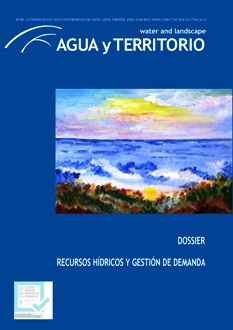L'avenir de la gestion intégrée «eaux usées traitées / agriculture périurbaine» en Tunisie. Cas du périmètre d'irrigation public (PRP) de Zaouia (Susa)
DOI :
https://doi.org/10.17561/at.13.4115Mots-clés :
Gestion intégrée, Eaux usées traitées, Agriculture périurbaine, Le ZRP de ZaouiaRésumé
Les eaux usées traitées étaient des ressources et leur utilisation dans les pays arides et semi-arides est une question internationale. L'article traite du processus de gestion intégrée «eaux usées traitées / agriculture périurbaine» en Tunisie et de ses conflits environnementaux et sociaux. La recherche est basée sur la combinaison de la méthode d'évaluation du paysage, Évaluation du caractère du paysage (ACV) et des entretiens avec des agriculteurs de la zone d'irrigation publique (ZRP) de Zaouia, qui permet de caractériser le paysage de la région. étudier et expliquer la perception des agriculteurs, en particulier, de l'utilisation des eaux usées traitées et de leurs interactions avec les autres acteurs du territoire. Les résultats seront un outil d'aide à la décision et développeront le compromis entre les eaux usées traitées et l'agriculture périurbaine.
Téléchargements
Références
Angelakis, A. N.; Marecos Do Monte, M. H. F.; Bontoux, L. y Asano, T. 1999: “The status of wastewater reuse practice in the Mediterranean basin: need for guidelines”, Water Research, 33(10), 2201-2217, https://doi.org/10.1016/S0043-1354(98)00465-5
Bouraoui, M. y Houman, B. 2008: “Valorisation des eaux pluviales et grises en agriculture urbaine pour l’amélioration des conditions socio-économiques des populations défavorisées: Le cas de la ville de Soukra dans le Grand Tunis”, en Vidal R (dir.): La diversité de l’agriculture urbaine dans le monde, vol. 3 des actes du colloque Les agricultures périurbaines, un enjeu pour la ville. Paris, 'Ecole Nationale Supérieure de la Police-Université de Nanterre, 109-118.
Fernández Álvarez, R. 2015: “La Aplicación de Landscape Character Assessment a los espacios de montaña media: el paisaje del macizo de las Villuercas”, Ciudad y Territorio. Estudios Territoriales, XLVII(185), 499-518.
Hamrita, A. 2017: Le devenir des espaces agricoles et naturels dans le territoire de la ville métropolitaine. De la protection au projet de paysage. Cas du Grand Sousse, Tesis Doctoral, Universidad de Sousa y Universidad Autónoma de Madrid, Túnez.
Hamrita, A.; Boussetta, A.; Mata Olmo, R.; Saqalli, M. y Rejeb, H. 2017: “Integrated water management and durability of landscape of public irrigated areas in tunisia: cases of public irrigated areas of Chott-mariem and Mornag”, International Journal of Research–Granthaalayah, 5(1), 73-89, https://doi.org/10.5281/zenodo.260280
Hurni Jensen, L. 2004: Is Landscape Character Assessment the work of public policy?, University of Nottingham, 1-9.
Journal Officiel de la République Tunisienne, 1983.
Kessira, M. 2005: “Gestion de l'irrigation avec les eaux non conventionnelles”, en Hamdy, A. (ed.): The use of non conventional water resources. CIHEAM, Options Méditerranéennes, Série A, Séminaires Méditerranéens, 66, 203-216.
Kochbati, H. 2009: Aménagement des eaux dans les villes en Tunisie. s. d.
Lebdi, F. 2005: “Appui pour l’irrigation et la gestion des systèmes hydrauliques”, CIHEAM, Options Méditerranéennes, Série B, Etudes et Recherches, 52, 193-203.
Marlet, S. y Mnajja, A. 2016: Guide pour l’action : transfert de la gestion des périmètres publics irrigués aux associations d’irrigants en Tunisie. Tome 1 : Mise en œuvre et adaptation de la stratégie nationale. Retour d’expérience du projet PAP-AGIR pour l’autonomie progressive des associations, Montpellier, CIRAD.
Monteverdi, M. C.; Da Canal, S.; Del Lungo, A.; Masi, S.; Larbi, H. y De Angelis, P. 2014: “Re-use of wastewater for a sustainable forest production and climate change mitigation under arid environments”, Annals of Silvicultural Research, 38(1), 22-31, http://dx.doi.org/10.12899/asr-778
Naser Abroug, S. 2014: Traitement et réutilisation des eaux usées traitées en Tunisie. Túnez, Office National de l’Assainissement
Nicolás, E.; Pedrero, F.; Alarcón, J. J;. Mounzer, O.; Martínez, V.; Nor¬tes, P. A; Alcón, F.; Egea, G. y De Miguel, M. D. 2012: Estudio de la viabilidad de uso de las aguas regeneradas procedentes de la EDAR de Jumilla en la Comunidad de Regantes Miraflores. Cartagena, Universidad Politécnica de Caartagena
Office National de l’Assainissement, 2009.
Office National de l’Assainissement, 2010.
Pérez Morales, P. Gil Meseguer, E. Gómez Espín, J.M. 2014: “Las aguas residuales regeneradas como recurso para los regadíos de la demarcación hidrográfica del segura (España)”, Boletín de la Asociación de Geógrafos Españoles, 64, 151-175, https://doi.org/10.21138/bage.1691
Pérez, S.; Köck, M. L.; Tong. Ginebreda, A.; López-Serna, R.; Postigo, C.; Brix, R.; López De Alda, M.; Petrovic, M;. Wang, Y. y Barcelo, D. (2012): “Wastewater Reuse in the Llobregat: The Experience at the Prat de Llobregat Treatment Plant”, en Sabater S., Ginebreda A., Barceló D. (eds): The Llobregat. The Story of a Polluted Mediterranean River, Berlin, Springer, 327-346, http://dx.doi.org/10.1007/698_2012_151
Swanwick, C. 2002: Landscape Character Assessment. Guidance for England and Scotland. Cheltenham – Edinburgh, The Countryside Agency and Scottisch Natural Heritage.
Termorshuizen, J. y Opdam, P. 2009: “Landscape services as a bridge between landscape ecology and sustainable development”, Landscape Ecology, 24(8) 1037-1052, https://doi.org/10.1007/s10980-008-9314-8
Tudor, Ch. 2014: An Approach of Landscape Character Assessment, s. l., Natural England
Téléchargements
Publié
Numéro
Rubrique
Licence
© Universidad de Jaén-Seminario Permanente Agua, territorio y medio ambiente-CSIC.
Les originaux publiés dans les éditions imprimées et électroniques de cette revue sont la propriété de l'Université de Jaén et du Seminario Permanente Agua, territorio y medio ambiente (CSIC), ainsi que des universités qui publient des monographies spécifiques en Amérique latine ou en Europe. L'origine doit être citée dans toute reproduction partielle ou totale.
Sauf indication contraire, tous les contenus de l'édition électronique sont distribués sous une licence "Creative Commons Attribution 4.0 Spain" (CC-by). Vous pouvez consulter ici la version informative et le texte légal de la licence. Cette circonstance doit être expressément mentionnée de cette manière lorsque cela est nécessaire.














